![]()
Wild in Middle America
Cleveland Ohio 1996
Tuesday November 5
What a desert! I’m experiencing the ennui and the deprivation of being in middle America without a car. Here I am in a university campus and there’s no decent bookstore within walking distance. The University Bookstore peddles texts, sweatshirts and a cornucopia of computer products; but real books? Forget it! The remainder shelves contain the most interesting items in the shop, including Jonathan Williams’ Quote, Unquote, a brilliant potpourri of tasty, nourishing soundbites. In other words, books too good to stay in print.
Perhaps I should drown my sorrows in drink. Next door is a deli which sells booze. I can’t believe the labels: all the hard stuff is diluted—cut to about 22% alcohol. What’s the source of this insanity? I learn that the deli doesn’t have a state liquor license, but can still peddle this watered-down stuff. What hypocrisy! As with the bookstore: don’t sell items of such undiluted concentration as to over-stimulate the public.
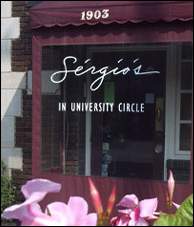
But food is something else. Most of us Americans who are clued up, or want to be, take food seriously, even pretentiously. The result is that the only serious retail outlets of any kind in close proximity to my hotel are two extremely good restaurants. One, called Sergio’s, is putatively Brazilian and last night was serving as a special the grilled ribs of an exotic Amazonian fish called tambaqui, which purportedly eats nuts and berries (how it gets to them was not revealed). It arrives in Cleveland in frozen chunks, but that’s no great sacrifice, since it’s a firm, meaty fish like tuna or anglerfish. Served on a bed of spicy rice, quite delicious.
Permanently on the menu is “Brazilian style bouillabaisse”. Nothing to do with the Provencal variety, but then fish stews of this sort all over the world were born out of whatever didn’t sell that day, dressed up with the local seasonings. This one took me back to my childhood in Provincetown, where the local Portuguese fisherman served up strong spicy stews which would have been interchangeable with this Brazilian version. No nouvelle cuisine here; two courses sent me away bursting at the seams.
Here in mid-continent the fish, mussels and clams can be faultlessly fresh. But this shouldn’t surprise me. A dozen years ago in Austin, Texas, I ate a broiled Maine lobster which had been glowering at me from a tank a few minutes before (no wonder). Too full to finish it, I asked if I could take the claws home to Mary in London and was promptly supplied with a dry-iced doggy bag. Those lobster claws were as well-traveled as Santa Claus.
Wednesday November 6
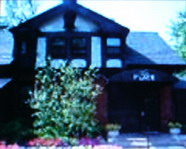 Down a back alley is another serious restaurant which calls itself dismissively,
That Place on Bellflower . Here the cuisine is decidedly eclectic, though calling itself “French-inspired”. My starter was a broccoli soup consisting of both pureed and chopped broccoli, rich with thick cream and enough strong parmesan to make me wish that I’d ordered a tureen of the stuff. Until my main course arrived, that is, which was a jamboulaya with lots of shrimp, chicken, chorizo sausage, poblanos peppers, mushrooms, peas and almond rice. Another great spicy fish stew - I could eat them every day! It was assertive enough to stand up to a mature ‘89 Cahors of the old-fashioned black malbec variety, a bargain in any restaurant in the world at twenty dollars. Again, a couple of courses were enough even for a glutton (me). Two stars, one in each eye.
Down a back alley is another serious restaurant which calls itself dismissively,
That Place on Bellflower . Here the cuisine is decidedly eclectic, though calling itself “French-inspired”. My starter was a broccoli soup consisting of both pureed and chopped broccoli, rich with thick cream and enough strong parmesan to make me wish that I’d ordered a tureen of the stuff. Until my main course arrived, that is, which was a jamboulaya with lots of shrimp, chicken, chorizo sausage, poblanos peppers, mushrooms, peas and almond rice. Another great spicy fish stew - I could eat them every day! It was assertive enough to stand up to a mature ‘89 Cahors of the old-fashioned black malbec variety, a bargain in any restaurant in the world at twenty dollars. Again, a couple of courses were enough even for a glutton (me). Two stars, one in each eye.
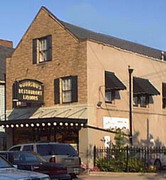 A few blocks away was a promising ethnic area called Little Italy, where I went for lunch to
Guarino’s , “ Cleveland’s oldest family restaurant”, founded in 1918. The bread which arrived must have been left over from opening day, the salad was hunks of iceberg lettuce thrown on a plate and dowsed with cheap oil and vinegar, and the lasagna was about two percentage points better that a frozen package. My glass of Chianti might have been poured in error from the vinegar bottle. So much for family values.
A few blocks away was a promising ethnic area called Little Italy, where I went for lunch to
Guarino’s , “ Cleveland’s oldest family restaurant”, founded in 1918. The bread which arrived must have been left over from opening day, the salad was hunks of iceberg lettuce thrown on a plate and dowsed with cheap oil and vinegar, and the lasagna was about two percentage points better that a frozen package. My glass of Chianti might have been poured in error from the vinegar bottle. So much for family values.
AT LEAST there was the excitement of the Clinton vs Dole presidential election. Looking forward to channel-hopping among the major networks, CNN and C-span (two cable-supported public affairs channels), I settled down at 8 p.m. eastern standard time for a long night of state-of-the-art reportage and analysis. Where was it? Party hacks and commentators alike were serving up the same dreary platitudes. C-span went to a succession of party HQs, pointed the camera, and went out for a beer. As the outcome became predictable—another four years of the same old thing—the networks reverted to mayhem and sitcoms. I began to wish that I were watching the returns back home on the BBC, where professional competence and lack of commercial pressures were probably combining to produce serious analysis. (When a dog contracts eczema, its fleas get really worried.)
One commentator mentioned in passing that the turnout had been the lowest since 1924. That was when women were first given the vote and hadn’t got into the habit of using it. Another pointed out that neither major party had done any campaigning in deprived areas. Perhaps they were afraid of being mobbed, or perhaps they knew the poor voters wouldn’t bother to turn out anyway.
But Oregon, with its mail-voting system, achieved better than 80% turn-out. Next there’s the possibility of computer voting. Extend direct democracy by means of instant referendum, and we could have our domestic and foreign policy changing as often and as rapidly as the leading brands of soap powder. It would be like they said of France after de Gaulle, but updated: Go to London and watch the changing of the guard; then go to Washington and watch the changing of the governments.
Some are urging that we protest against the quality of the parties and candidates by not voting. In a putative democracy, this is about as productive as protesting against the quality of air by refusing to breathe. In the 1930’s the poor decided to turn out en masse; we’re still talking about it.
VOTE NO FOR PRESIDENT said a sixties bumper sticker. That’s not just staying away from the polls, it’s a positive act. Imagine the impact of millions of voters writing NO! across their ballot papers. Hard to do with voting machines, though—they don’t make them with “no for president” levers.
Thursday November 7
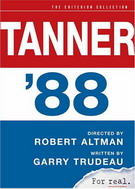 Two days after the election comes a rebroadcast of an excellent documentary on the early directors of live TV drama—Penn, Frankenheimer, Wexler, Altman—who left TV when it became unrelievedly commercial and briefly took over Hollywood. There’s an excerpt from
Tanner 88 , Altman’s docu-drama in which an imaginary candidate joins the real ones in New Hampshire’s primary race. My God, what character, what intelligence! If the film had been made this year, Tanner might well have won as a write-in candidate. Of course we had Ralph Nader, but you wouldn’t know it from the TV and newspaper coverage. [2007 footnote: It’s interesting to compare Tanner 88 with West Wing: uncertain, low-key people vs. tightly scripted smart-alecs.]
Two days after the election comes a rebroadcast of an excellent documentary on the early directors of live TV drama—Penn, Frankenheimer, Wexler, Altman—who left TV when it became unrelievedly commercial and briefly took over Hollywood. There’s an excerpt from
Tanner 88 , Altman’s docu-drama in which an imaginary candidate joins the real ones in New Hampshire’s primary race. My God, what character, what intelligence! If the film had been made this year, Tanner might well have won as a write-in candidate. Of course we had Ralph Nader, but you wouldn’t know it from the TV and newspaper coverage. [2007 footnote: It’s interesting to compare Tanner 88 with West Wing: uncertain, low-key people vs. tightly scripted smart-alecs.]
THERE’S A great art museum just around the corner. I arrive at 10 a.m., just as it opens, together with two school buses full of noisy kids. At the information desk I learn that the tours are usually over by the afternoon and so I walk out into fresh post-downpour air. There’s definitely a place for small children in an art gallery—some other place.
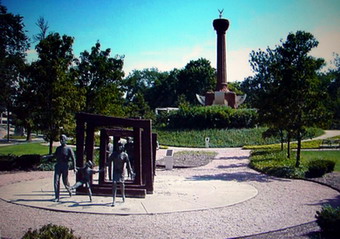 Nearby there’s a monumental piece of contemporary sculpture to visit, the Cancer Survivors’ Monument in Wade Park. It’s incredible; the Cleveland Plain Dealer unequivocally headlined its write-up, “A Public Shame”. I searched in vain for the name of Robert Crumb, who must have been involved at least in the designing stage. In a lifetime of viewing truly degenerate monumental art, this is perhaps the sickest.
Nearby there’s a monumental piece of contemporary sculpture to visit, the Cancer Survivors’ Monument in Wade Park. It’s incredible; the Cleveland Plain Dealer unequivocally headlined its write-up, “A Public Shame”. I searched in vain for the name of Robert Crumb, who must have been involved at least in the designing stage. In a lifetime of viewing truly degenerate monumental art, this is perhaps the sickest.
A fifty-foot tumescent column in sculpted brick is reached by a spiraling “Positive Mental Attitude Path” which arrives at a curving pergola of steel columns bearing, in immortal bronze, saccharine messages of hope, each more nauseating than the one before. The growths on the column turn out to be clusters of flora and fauna - nature run amok. Beyond the other side of the column is a sculpture group of cancer sufferers of all ages, approaching the monument through a “maze” of successive open rectangles and emerging joyfully on the near side. Unfortunately the sculptures were already in place before the patio was poured, and so their feet are symbolically embedded in cement. As an ailing pilgrim, I’d find the message less than hopeful; allegories are more efficacious in the abstract than in the concrete.
So where did the money for this shocker come from? It turns out to be a gift from Richard Bloch, co-founder of a tax consulting service. After successfully beating both the Grim Reaper and the Internal Revenue, he set aside fifty million bucks to erect hideous monstrosities in fifty unlucky cities. No Carnegie or Rockefeller he. Let’s hope that his ego trips last no longer than the Soviet war monuments in the Balkan countries.
Friday November 8
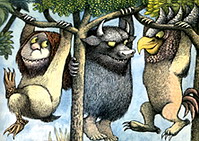
The ostensible reason for all this eating and drinking is three concert performances of Oliver Knussen’s
Where the Wild Things Are , an opera for children of  all ages based on Maurice Sendak’s legendary picture book and staged with great success at Glyndebourne a dozen years ago. On this occasion, Ollie has doubled the size of the orchestra, and the amplified voices of the Wild Things go whizzing about the hall over a grand total of sixteen Meyer loudspeakers. Great fun—it’s like being at the controls of an F-111! The Cleveland Orchestra is every bit as good as it’s cracked up to be and Severance Hall is one of the world’s great concert venues.
all ages based on Maurice Sendak’s legendary picture book and staged with great success at Glyndebourne a dozen years ago. On this occasion, Ollie has doubled the size of the orchestra, and the amplified voices of the Wild Things go whizzing about the hall over a grand total of sixteen Meyer loudspeakers. Great fun—it’s like being at the controls of an F-111! The Cleveland Orchestra is every bit as good as it’s cracked up to be and Severance Hall is one of the world’s great concert venues.
But the critic for the Cleveland Plain Dealer dealt plainly with the music, finding it harsh and dissonant with no magic and no melodies. Ollie Knussen too “modern”?? The reviewer’s sub-text was that he would have preferred an Andrew Lloyd Weber-style musical. But the blue-rinse dowagers lapped it up regardless, and so they should. The opera owes more to Debussy and Ravel (it’s a worthy sequel to L’Enfant et les Sortilèges) than to Schoenberg, and Charles Ives’ challenge to “Stand up and use your ears like a man!” is met more easily these days by middlebrow punters of both sexes, partly due to a steady diet of atonal mood music in horror films. (The redoubtable Elizabeth Lutyens churned out innumerable scores for Hammer.)
ALL OF US performers from London were taken out to dinner by the orchestral management on Tuesday night at a highly regarded Indian restaurant, the Café Tandoor. A serious London foodie does not normally travel halfway around the world for a poppadom, but the food had character (terrific garlic prawns!) and the sauces of the various dishes, which were passed around, had not all come from the same pot. My pleasure was slightly tempered by a news item this morning in the Cleveland Plain Dealer which reported that at least 120 members of the Pakistani Students Association had come down with food poisoning after a banquet catered a couple of days before by the same restaurant. But the restaurant was cleared by the Board of Health—must have been just a coincidence.
Saturday November 9
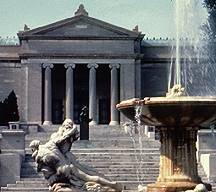 Back twice to the
Cleveland Museum of Art , on two successive days. What a collection! It was put together by old Cleveland money, not the rum-running fortunes of the jazz age that set up the Las Vegas gambling industry. It claims to be one of the five best in the US. Who adds up the points? When you’re this good, it doesn’t matter. That’s the problem with big-business rating systems like ice-skating scores and Michelin stars: activities which are not essentially combative are turned into cut-throat competitions in which irrelevant details such as a runny nose or a creased napkin spell the difference between success and failure.
Back twice to the
Cleveland Museum of Art , on two successive days. What a collection! It was put together by old Cleveland money, not the rum-running fortunes of the jazz age that set up the Las Vegas gambling industry. It claims to be one of the five best in the US. Who adds up the points? When you’re this good, it doesn’t matter. That’s the problem with big-business rating systems like ice-skating scores and Michelin stars: activities which are not essentially combative are turned into cut-throat competitions in which irrelevant details such as a runny nose or a creased napkin spell the difference between success and failure.
I start with the oriental collections on the lower levels, wandering through a room of early Chinese art in which I was gob-smacked by the elegance, wit and sophistication. The dates are humbling—these masterpieces were created when my ancestors were “ethnic”.
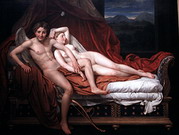 Upstairs on the walls in the European rooms are a lot of old friends who, I’m amazed to discover, actually live in Cleveland. There is Jacques Louis David’s Cupid and Psyche, a big erotic painting of Cupid slipping s
Upstairs on the walls in the European rooms are a lot of old friends who, I’m amazed to discover, actually live in Cleveland. There is Jacques Louis David’s Cupid and Psyche, a big erotic painting of Cupid slipping s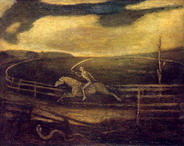 lyly out of bed so as not to awaken his lover and wearing nothing but what in the army we called a shit-eating grin. In the 20th century American section is Albert Pynkham Ryder’s Race Track. Pale horse, pale rider—death galloping hell for leather around an empty course. The heavy irony sat comfortably with his literary contemporaries; Mark Twain or Ambrose Bierce would have nodded wryly.
lyly out of bed so as not to awaken his lover and wearing nothing but what in the army we called a shit-eating grin. In the 20th century American section is Albert Pynkham Ryder’s Race Track. Pale horse, pale rider—death galloping hell for leather around an empty course. The heavy irony sat comfortably with his literary contemporaries; Mark Twain or Ambrose Bierce would have nodded wryly.
A cornucopia of Van Goghs, Goyas, El Grecos, Gainsboroughs (I seem to have a thing about the letter G) and just about anybody you might name keep me occupied for hours. There’s even a Tarbell, a minor Boston painter whose name I knew at a tender age because he had a summer home on Cape Cod in Chatham, where I was born.
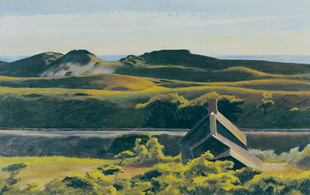 But for me, the most arresting is an unfamiliar Edward Hopper: a view over the South Truro dunes to the sea, with a weather-beaten Cape Cod cottage in the foreground. The picture dates from 1930, the year before I was born, when he first began to vacation on the Cape. Browsing afterwards in the museum bookstore I find a reproduction of another South Truro Hopper [below], this one called Cobb’s Barns. The South Truro Cobbs! They were related to the Collinsons, our next door neighbours in Provincetown who let us spend a couple of weeks in the old Cobb Cottage one summer, tucked away down a derelict post road which had become only a wide needle-strewn track under huge pine trees.
But for me, the most arresting is an unfamiliar Edward Hopper: a view over the South Truro dunes to the sea, with a weather-beaten Cape Cod cottage in the foreground. The picture dates from 1930, the year before I was born, when he first began to vacation on the Cape. Browsing afterwards in the museum bookstore I find a reproduction of another South Truro Hopper [below], this one called Cobb’s Barns. The South Truro Cobbs! They were related to the Collinsons, our next door neighbours in Provincetown who let us spend a couple of weeks in the old Cobb Cottage one summer, tucked away down a derelict post road which had become only a wide needle-strewn track under huge pine trees.
The cottage itself was a time capsule. No electricity, no running water, but a handpump over the kitchen sink—in spite of the close proximity of the ocean, you could draw fresh water from wells all over the Cape, even in the sand dunes out near the end. One road in Truro followed the top of a long dune with the salt water of the bay on one side and a big freshwater pond on the other—even the elements knew their place in those days!
But the most amazing thing about the Cobb Cottage was that nothing seemed to have been added or subtracted since the nineteenth century. Not just the kerosene lamps and the Victorian furniture, but everything, including the neat stacks of newspapers—strong unyellowed paper that didn’t have to be handled gingerly—which told me, in their long detailed reports, the latest developments in the Civil War. When I tired of reading there was a stereopticon viewer and boxes of 3D slides which transported me back to the cities and the scenery of half a century before.
I realize with a shock that the half-century time lapse I’m describing has now doubled. Whatever happened to the Cobb Cottage? In an intercultural liaison, Bob Collinson, maybe a dozen years older than me, married Grace Gouveia, who was my seventh-grade English teacher and the first of the Catholic Portuguese fishermen’s children to go away to college. The outcome was not happy. The house, as well as the marriage, is now probably a wreck, like the hundreds of ships that ventured too close to the Cape on stormy nights.
Here in Cleveland there’s also a storm. There’s been a fall of heavy wet snow which has brought down trees all over the city. I’m awakened in the middle of the night by the voice of a man outside in the hall, desperate, half-sobbing: “Tonight’s nothin’ unusual! You wreck your car, you’re stuck somewhere!”
Monday November 11
Another nail-biting connection—a prop-driven relic to Chicago which is a half hour late and threatens to miss my AA flight to London. But there’s plenty of time after all. I’m fed an infuriating dinner: Cajun shrimp on a bed of spicy rice, with al dente sliced carrots and manche tout peas, all of which are so good that if the plane were a restaurant I’d come back. The techniques which allow luxury restaurants to get away with serving from the freezer via the microwave are feeding through to the airlines; sometimes they work.
I’m always complaining about deceptive cuisine. If I’m an old grouch, then so be it. I think it’s sad whenever anything artificial—be it music, food, intelligence or sex—becomes so good that people no longer miss the real thing.
These long overnight flights against the sun involve a careful equation: how much booze will knock me out without the penalty of a hangover? This time I opt for two bottled Tanqueray martinis, two small bottles of white wine, and a cognac. Perfect. I doze off during the opening scene of Emma (which I’m told would have done the trick all by itself) and the next thing I hear is the announcement that we’ll be landing at Heathrow in half an hour. No hangover. I’ve made it through the night. Maybe this is the way to get through life. I think in my next incarnation I’ll be an alcoholic.
©1996 John Whiting